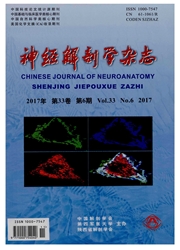

 中文摘要:
中文摘要:
目的:探讨大鼠后足切割后脊髓ERK的表达情况。方法:以大鼠右后足切割作为急性疼痛模型;用免疫组织化学法测试脊髓磷酸化ERK(pERK)表达情况。ERK抑制剂U0126(1μg)在切割前20min或切割后20min鞘内注射。用von Frey纤维测试大鼠机械性痛敏。结果:大鼠后足切割后1min,在切割侧L4-L5脊髓浅层背侧角(板层Ⅰ和板层Ⅱ)ERK被迅速地激活,并在5min达到峰值,随后恢复到基础值。切割前鞘内给予U0126能显著减轻机械性痛敏,然而,切割后鞘内给予U0126对机械性痛敏的作用并不明显。结论:脊髓ERK在大鼠后足切割痛中产生机械性痛敏发挥了重要的作用。
 英文摘要:
英文摘要:
Objective: The current study aims to explore the role of ERK in spinal cord in incisional pain. Methods: Rats were re- ceived one hind paw incision; pERK1/2 (p44/42) in spinal cord was measured by immunohistochemistry. ERK inhibitor, U0126 (1μg) was intrathecally injected 20 min before or after incision. Pain hypersensitivity was assessed by von Frey test. Results: The expression of ERK in the ipsilateral L4-L5 spinal superficial dorsal horn (lamina I and II) was activated at lmin immediately after hind paw incision in rats, followed by reaching a peak at 5 min, and then returned to basal level thereafter. Pretreatment with U0126 dramatically attenuated the mechanical pain hypersensitivity induced by hind paw incision. However, U0126 post-treatment had only marginal effect on incision- evoked mechanical pain hypersensitivity. Conclusions: ERK activation in spinal dorsal horn plays an important role in the development of pain hypersensitivity induced by surgical incision.
 同期刊论文项目
同期刊论文项目
 同项目期刊论文
同项目期刊论文
 Activation of spinal ERK1/2 contributes to mechanical allodynia in a rat model of postoperative pain
Activation of spinal ERK1/2 contributes to mechanical allodynia in a rat model of postoperative pain Analgesic effects of the COX-2 inhibitor parecoxib on surgical pain through suppression of spinal ER
Analgesic effects of the COX-2 inhibitor parecoxib on surgical pain through suppression of spinal ER Biphasic Activation of Extracellular Signal-regulated Kinase in Anterior Cingulate Cortex Distinctly
Biphasic Activation of Extracellular Signal-regulated Kinase in Anterior Cingulate Cortex Distinctly 期刊信息
期刊信息
